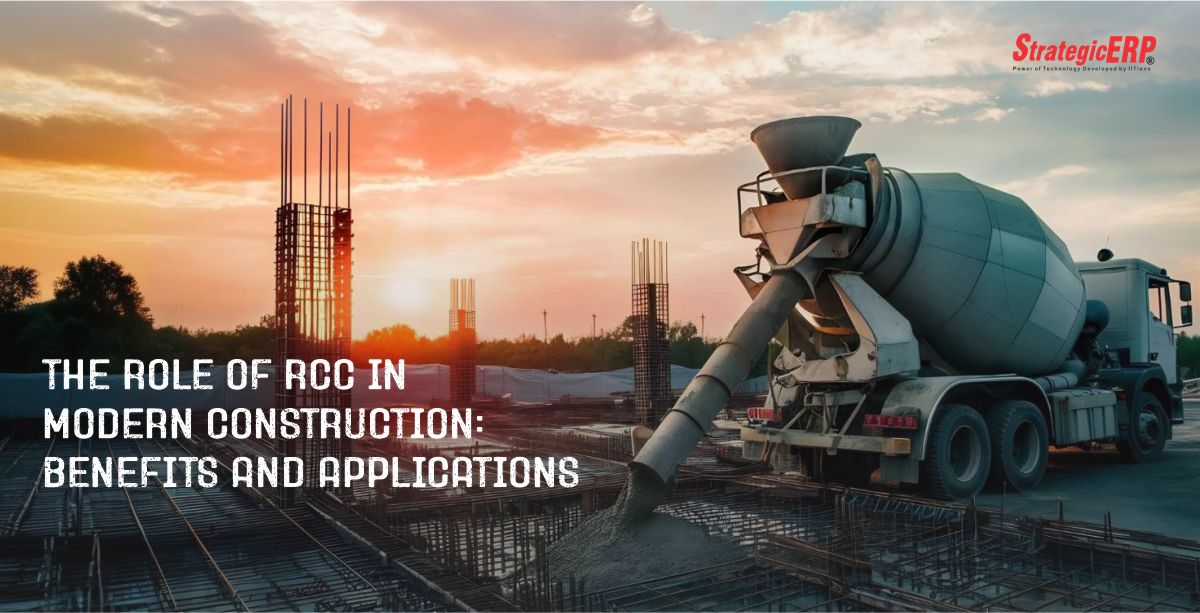The Role of RCC in Modern Construction: Benefits and Applications
Category : Digital Transformation
Blog posted by : Admin / 15 Feb, 2025
Reinforced Cement Concrete (RCC) has revolutionized modern construction by offering unmatched strength, durability, and flexibility. By integrating steel reinforcement with concrete, RCC overcomes the limitations of Plain Cement Concrete (PCC), making it a preferred material for high-rise buildings, bridges, dams, and industrial structures. With advancements in cloud-based construction ERP software, companies like StrategicERP provide comprehensive solutions for managing RCC-based construction projects with greater efficiency, accuracy, and cost-effectiveness.
Understanding Reinforced Cement Concrete (RCC)
Image source: Home Improvement & Decor
Composition and Materials Used
The best materials used in Reinforced Cement Concrete (RCC) will define the amount of usage in construction-related work. The strength and reliability of RCC depend on the quality of its components:
|
Material |
Function |
|
Cement |
Binds the aggregates and reinforcement together |
|
Fine Aggregates |
Fills voids between larger particles and improves workability |
|
Coarse Aggregates |
Provides compressive strength and bulk to concrete |
|
Water |
Reacts with cement to initiate hydration and setting |
|
Steel Reinforcement |
Enhances tensile strength and prevents cracks |
StrategicERP's AI-based mix design computation guarantees the optimum material ratios for improved RCC performance, minimizing wastage of material and cost.
RCC vs. PCC: Key Differences
RCC vs Plain Cement Concrete (PCC) have major differences in their area of work. Unlike Plain Cement Concrete (PCC), which lacks tensile strength, Reinforced Cement Concrete (RCC) integrates steel bars or mesh, making it suitable for load-bearing structures.
|
Features |
RCC |
PCC |
|
Tensile Strength |
High (due to steel reinforcement) |
Low |
|
Durability |
High |
Moderate |
|
Applications |
Bridges, buildings, dams, flyovers |
Pavements, flooring, non-load bearing walls |
|
Cost |
Higher initial investment, lower long-term maintenance |
Lower cost but requires frequent repairs |
Applications of RCC in Construction
RCC is extensively used in high-rise buildings, bridges, dams, and industrial plants, ensuring structural integrity under extreme conditions.
-
Skyscrapers & Residential Towers
Handles vertical loads and seismic activities.
-
Bridges & Flyovers
Offers high load-bearing capacity and resilience.
-
Dams & Water Reservoirs
Withstands hydrostatic pressure and environmental wear.
-
Industrial & Commercial Complexes:
Supports heavy machinery and large spaces without intermediate supports.
Challenges in RCC Construction & StrategicERP’s Solutions
Despite its benefits, RCC construction faces several challenges that StrategicERP’s inventory management and construction ERP software can efficiently address:
|
RCC Construction Challenges |
StrategicERP’s Solution |
|
Material Wastage |
AI-powered inventory management optimizes raw material usage, reducing waste. |
|
Time-Consuming Estimations |
Automated BOQ (Bill of Quantities) ensures precise cost estimations. |
|
Structural Safety Risks |
Automated compliance tracking ensures adherence to safety norms. |
|
Project Delays |
Cloud-based scheduling enhances project tracking and timelines. |
|
Cost Overruns |
Real-time cost tracking prevents budget overruns. |
Advantages of Using RCC in Construction Projects
The RCC construction advantages display that the blend of concrete and steel reinforcement provides better performance:
1. Enhanced Strength & Load-Bearing Capacity
RCC can resist compressive and tensile stresses, thus being suitable for large-scale construction
2. Durability & Resistance to Environmental Factors
RCC structures are resistant to corrosion, fire, and seismic movements, providing durability.
3. Cost-Effectiveness Over the Long Term
While RCC is more expensive in the beginning, low maintenance needs to cut down on long-term costs. With the best infrastructure ERP, this can achieved effectively.
4. Flexibility in Architectural Design
RCC can be cast into intricate designs, providing flexible architectural formations.
Future Trends in RCC Construction
The RCC industry is embracing smart technologies for better efficiency and sustainability.
1. High-Performance Concrete (HPC)
New formulations of HPC improve strength, durability, and workability for modern structures.
2. Automation & AI in RCC Projects
AI-powered construction management software, such as StrategicERP, optimizes the allocation of resources, budgets, and work schedules.
3. Eco-Friendly RCC Solutions
Use of recycled aggregates, fly ash, and low-carbon types of cement to meet sustainability goals.
How StrategicERP Enhances RCC Construction
StrategicERP provides an all-in-one cloud ERP solution tailored for RCC construction projects, offering features such as:
|
Features |
Benefits for RCC Construction |
|
AI-Driven Material Estimation |
Reduces cost and material wastage |
|
Project Scheduling & Monitoring |
Ensures timely completion |
|
Automated Compliance Tracking |
Helps meet safety and regulatory standards |
|
Cloud-Based Documentation |
Facilitates seamless data access and collaboration |
|
Mobile App Integration |
Enables real-time project tracking from anywhere |
Conclusion
Reinforced Cement Concrete (RCC) is still the cornerstone of contemporary infrastructure, offering strength, durability, and design versatility. However effective RCC project management calls for sophisticated digital tools.
Using StrategicERP's cloud-based ERP solution for the construction industry, organizations can optimize utilization, simplify business workflows, and have cost-efficient high-quality constructions. Through integration with AI-technology-enabled intelligence and automation, RCC constructions are being executed more precisely and with greater profitability.
Businesses can also explore these capabilities firsthand through a construction ERP software demo, ensuring seamless project execution and enhanced decision-making.
Frequently Asked Questions (FAQs)
1. What is the primary advantage of RCC over PCC?
RCC provides higher tensile strength and durability due to steel reinforcement, making it suitable for load-bearing structures.
2. How does StrategicERP improve RCC construction projects?
StrategicERP enhances RCC construction through AI-driven material estimation, cost tracking, compliance automation, and real-time project monitoring.
3. What are the major challenges in RCC construction?
Challenges include material wastage, cost overruns, project delays, and structural safety risks, all of which can be addressed through StrategicERP’s cloud-based solutions.
4. How can RCC construction become more sustainable?
By incorporating recycled materials, energy-efficient techniques, and AI-driven project optimization, RCC can contribute to eco-friendly construction.







